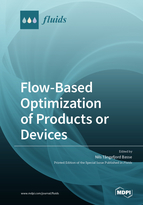Flow-Based Optimization of Products or Devices
A special issue of Fluids (ISSN 2311-5521).
Deadline for manuscript submissions: closed (30 November 2019) | Viewed by 40107
Special Issue Editor
Special Issue Information
Dear Colleagues,
Flow-based optimization of products and devices is an immature field compared to corresponding optimization based on solid mechanics. However, it is an essential part of components with both internal and/or external flow. Examples of the quantities which can be optimized for flow include:
- pressure drop
- pressure transients
- flow noise
- turbulent mixing
- heat transfer
- energy/particle confinement in fusion plasmas
- fluidic oscillators
- rheology measurements
- swirl
- velocity profile symmetry
- manifold distribution
Flow-based optimization can be achieved by e.g. coupling of computational fluid dynamics (CFD) and optimization software; both open-source and commercial options exist. We invite contributions applying CFD-only or coupled approaches. Model-based (1D) optimization is also within the scope of this special issue. The motivation for flow-based optimization can be to improve performance, reduced size/cost, extract additional information or a combination of these objectives. The outcome of the optimization may be geometries which are more suitable for additive manufacturing instead of traditional subtractive manufacturing. Both original research and review papers are welcome.
Dr. Nils Tångefjord Basse
Guest Editor
Manuscript Submission Information
Manuscripts should be submitted online at www.mdpi.com by registering and logging in to this website. Once you are registered, click here to go to the submission form. Manuscripts can be submitted until the deadline. All submissions that pass pre-check are peer-reviewed. Accepted papers will be published continuously in the journal (as soon as accepted) and will be listed together on the special issue website. Research articles, review articles as well as short communications are invited. For planned papers, a title and short abstract (about 100 words) can be sent to the Editorial Office for announcement on this website.
Submitted manuscripts should not have been published previously, nor be under consideration for publication elsewhere (except conference proceedings papers). All manuscripts are thoroughly refereed through a single-blind peer-review process. A guide for authors and other relevant information for submission of manuscripts is available on the Instructions for Authors page. Fluids is an international peer-reviewed open access monthly journal published by MDPI.
Please visit the Instructions for Authors page before submitting a manuscript. The Article Processing Charge (APC) for publication in this open access journal is 1800 CHF (Swiss Francs). Submitted papers should be well formatted and use good English. Authors may use MDPI's English editing service prior to publication or during author revisions.
Keywords
- flow-based optimization
- internal and/or external flow
- modelling and simulation
- CFD
- additive manufacturing






